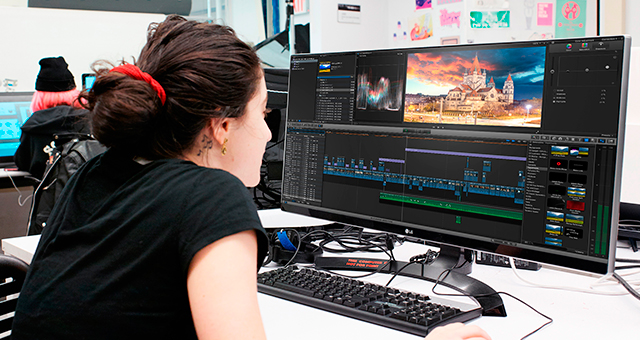Special Advertising Note: The following sponsored content is brought to you courtesy of LG, one of HOW’s trusted partners.
I practically live on my laptop. In fact, I’m writing this article on one at the moment. The flexibility of being able to carry your work with you is undeniable. But for design work, it’s equally undeniable that I can do my best work on a larger screen.
Here’s why we think you should make the switch to an ultrawide monitor:
The options are becoming more accessible.
One trend I’ve noticed lately is that tech companies are experimenting with screen shape and position—competing to give creative professionals a better experience while they work.
Image created for for the LG UltraWide Academy Program by littledrill creative
Focusing particularly on student creatives, LG has partnered with leading design institutions to create UltraWide Monitors that help students produce work that’ll transform their industries, from architecture to product design. It even boasts a sweet ergonomic curved design, which wraps around the user, makes long hours more comfortable and efficient.
The most recent partner in this grant program is The New School’s Parsons School for Design in New York City, which received a state-of-the-art computer lab featuring new LG 34” Class 21:9 UltraWide Monitors. And for 2017, LG is considering a range different specialized schools—including institutes for photography, film and design—to receive the UltraWide Academy Sponsorship Program.
Students using monitors provided by the UltraWide Academy Sponsorship Program
It makes you a more efficient designer.
According to a study by the University of Utah, using a larger monitor helped participants complete tasks up to 52% faster, saving an average 2.5 hours each day.
The 21:9 UltraWide monitor displays offer more visual information on screen at once, creating a workspace that enables designers to be more productive compared to the usual two-monitor setup.
“Personally I think creative professionals would definitely benefit from it,” said Joe, an illustration alumni from Parsons. “The monitor is basically the new drawing board, the color correction and what you see on screen should exactly be what you printed. And if you’re video editing, then there should be no lag whatsoever.”

Multitasking is much easier.
Design may be a two-handed job, but if you’re anything like me, it’s also a multi-window job. And I mean multi-window. (There definitely aren’t more than five programs and 20 windows open on my computer at the moment…)
But an ultrawide monitor’s enormous screen size allows for seamless multitasking through dozens of windows, and offers incredibly accurate color representation, eliminating sprints between the computer and printer to adjust color differences. The LG 34” Class 21:9 UltraWide Monitors, for example, utilize sRGB over 99% IPS technology, guaranteeing color accuracy with factory color calibration, and eliminating frustrating color shifting and distortion common with traditional monitors. It’s easy to adjust settings via the On-Screen Control and the monitors have a Screen Split function with 14 options for simple multitasking.
“It’s very wide and makes it easy to 3D model things or use Adobe Creative Suite, as the screen’s big enough to accommodate all the panels.” said Lorraine, a Product Design student.
…
So, whether you go for the LG UltraWide or experiment on another screen style, I am personally an advocate of larger screen sizes for designers. It’ll boost your productivity, make your design experience more immersive, and let you create more—and better—work.








You can easily check minor mistake as well.
large screen gives a better idea how beautiful design will look on big hoarding.